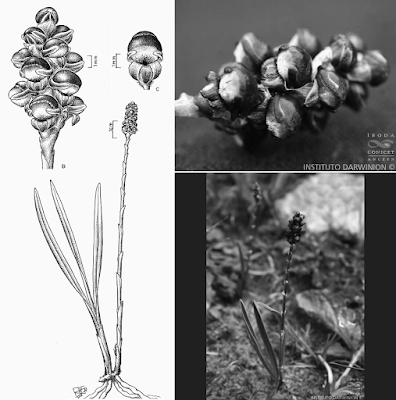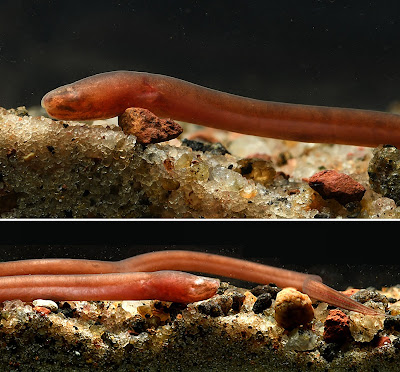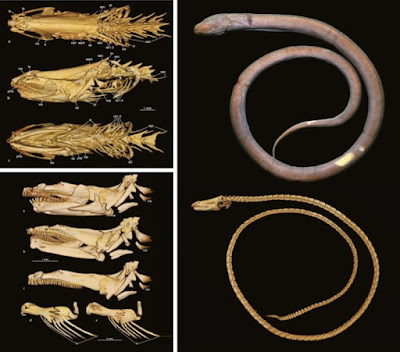[Most Recent Entries] [Calendar View]
Sunday, January 31st, 2021
| Time | Event | ||||
| 7:20a | [Botany • 2020] Aa tenebrosa • Aa (Orchidaceae) of Southern Central Andes: Taxonomy, Nomenclature, and A New Species with Dark Flowers
Abstract A new species, Aa tenebrosa , from the Yungas Montane Grasslands is described, illustrated, and compared to similar species. Descriptions, brief taxonomic notes, and data on the ecology of Aa species from the Southern Central Andes (Argentina) are provided. Keywords: Chorology; Yungas Montane Grasslands; morphological comparison Aa tenebrosa C.M. Martın & G.J. Scrocchi sp. nov. Etymology— From the Latin tenebra (darkness, shadow, obscurity) in reference to the colour of the flowers. Five species of Aa were recognized for the southern central Andes: Aa achalensis, Aa fiebrigii, Aa hieronymi, Aa weddelliana, and Aa tenebrosa. Claudia M. Martín, Christian A. Zanotti and Gustavo J. Scrocchi. 2020. Aa (Orchidaceae) of Southern Central Andes: Taxonomy, Nomenclature, and A New Species with Dark Flowers. Systematic Botany. 45(4); 760-766. DOI: 10.1600/036364420X16033962925178 Aa (Orchidaceae) del sur de los Andes centrales: Taxonomía, nomenclatura, y una nueva especie con flores oscuras The new species, Aa tenebrosa, is recognized as the second dark-flowered species of the genus. The first species described with dark flowers was leucantha, endemic to the Northern Andes (Colombia, Venezuela and Ecuador). The new species is distinguished by flower segments up to 2 mm (versus more than 3 mm in leucantha), pubescent rachis (versus glabrous in A. leucantha), and totally hairy ovary (versus hairy ovary at the apex in A. leucantha). Aa tenebrosa grows in the Montane Grasslands of the Yungas (southern Central Andes) and leucantha grows in the Páramo (northern Andes). Five species of Aa were recognized for the southern central Andes: Aa achalensis, Aa fiebrigii, Aa hieronymi, Aa weddelliana, and Aa tenebrosa. Descriptions, taxonomic notes and data on the ecology of Aa species from the southern central Andes are provided. Aa (Orchidaceae) del sur de los Andes centrales: Taxonomía, Nomenclatura, y una Nueva especie con flores oscuras La nueva especie, Aa tenebrosa, es reconocida como la segunda especie de flores oscuras de dicho género. La primera especie descripta con flores oscuras fue leucantha, endémica de Los Andes del Norte (Colombia, Venezuela y Ecuador). La nueva especie se distingue por los segmentos florales de hasta 2 mm (versus más de 3 mm en leucantha), raquis pubescente (versus glabro en A. leucantha) y ovario totalmente piloso (versus ovario piloso en el ápice en A. leucantha). Aa tenebrosa crece en los Pastizales Montanos de las Yungas (sur de Los Andes Centrales) y leucantha crece en el Páramo (Andes del norte). Se reconocieron cinco especies de Aa para el sur de los Andes centrales: Aa achalensis, Aa fiebrigii, Aa hieronymi, Aa weddelliana y Aa tenebrosa. Se proporcionan descripciones, notas taxonómicas y datos sobre la ecología de las especies Aa del sur de los Andes centrales. Nueva especie de orquidea de las yungas, Aa tenebrosa, se encuentra entre 3500 y 3730 m.a. Es la unica especie del grupo con flores de coloración oscura. Link para la publicación, con la participación del Dr. Scrocchi | ||||
| 3:29p | [Arachnida • 2020] The Systematics and Phylogenetic Position of the Troglobitic Australian Spider Genus Troglodiplura (Araneae : Mygalomorphae), with A New Classification for Anamidae
Abstract Compared with araneomorph spiders, relatively few mygalomorph spiders have evolved an obligate existence in subterranean habitats. The trapdoor spider genus Troglodiplura Main, 1969 and its sole named species T. lowryi Main, 1969 is endemic to caves on the Nullarbor Plain of southern Australia, and is one of the world’s most troglomorphic mygalomorph spiders. However, its systematic position has proved to be difficult to ascertain, largely due to a lack of preserved adults, with all museum specimens represented only by cuticular fragments, degraded specimens or preserved juveniles. The systematic placement of Troglodiplura has changed since it was first described as a member of the Dipluridae, with later attribution to Nemesiidae and then back to Dipluridae. The most recent hypothesis specifically allied Troglodiplura with the Neotropical subfamily Diplurinae, and therefore was assumed to have no close living relatives in Australia. We obtained mitochondrial sequence data from one specimen of Troglodiplura to test these two competing hypotheses, and found that Troglodiplura is a member of the family Anamidae (which was recently separated from the Nemesiidae). We also reassess the morphology of the cuticular fragments of specimens from several different caves, and hypothesise that along with T. lowryi there are four new troglobitic species, here named T. beirutpakbarai Harvey & Rix, T. challeni Harvey & Rix, T. harrisi Harvey & Rix, and T. samankunani Harvey & Rix, each of which is restricted to a single cave system and therefore severely threatened by changing environmental conditions within the caves. The first descriptions and illustrations of the female spermathecae of Troglodiplura are provided. The family Anamidae is further divided into two subfamilies, with the Anaminae Simon containing Aname L. Koch, 1873, Hesperonatalius Castalanelli, Huey, Hillyer & Harvey, 2017, Kwonkan Main, 1983, Swolnpes Main & Framenau, 2009 and Troglodiplura, and the Teylinae Main including Chenistonia Hogg, 1901, Namea Raven, 1984, Proshermacha Simon, 1909, Teyl Main, 1975 and Teyloides Main, 1985. Keywords: Australasia, Avicularioidea, molecular phylogenetics, Nemesioidina, taxonomy. Family Anamidae Simon, 1889 Subfamily Teylinae Main, 1985, stat. nov. Included genera: Chenistonia Hogg, 1901, Namea Raven, 1984, Proshermacha Simon, 1909, Teyl Main, 1975 and Teyloides Main, 1985. Subfamily Anaminae Simon, 1889 Included genera: Aname L. Koch, 1873, Hesperonatalius Castalanelli, Huey, Hillyer & Harvey, 2017, Kwonkan Main, 1983, Swolnpes Main & Framenau, 2009 and Troglodiplura Main, 1969 (the latter tentatively included; see Results and Discussion, above). Genus Troglodiplura Main, 1969 Type species: Troglodiplura lowryi Main, 1969, by monotypy. Troglodiplura lowryi Main, 1969 Troglodiplura challeni Harvey & Rix, sp. nov. Etymology: This species is named for Dr Craig Challen, in recognition of his contributions to cave diving and in particular his role in the rescue of 12 students and their coach from Tham Luang Nang Non cave, Thailand, in 2018. Troglodiplura harrisi Harvey & Rix, sp. nov. Etymology: This species is named for Dr Richard Harris, in recognition of his contributions to cave diving and in particular his role in the rescue of 12 students and their coach from Tham Luang Nang Non cave, Thailand, in 2018. Troglodiplura beirutpakbarai Harvey & Rix, sp. nov. Etymology: This species is named for the late Beirut Pakbara, who assisted in the rescue of 12 students and their coach from Tham Luang Nang Non cave, Thailand, in 2018, but tragically died from a resulting infection in 2019. Troglodiplura samankunani Harvey & Rix, sp. nov. Etymology: This species is named for the late Saman Kunan (1980–2018), in memory of his role in the rescue of 12 students and their coach from Tham Luang Nang Non cave, Thailand, in 2018.
Troglodiplura sp. ‘MYG602’ Mark S. Harvey, Michael G. Rix, Mia J. Hillyer and Joel A. Huey. 2020. The Systematics and Phylogenetic Position of the Troglobitic Australian Spider Genus Troglodiplura (Araneae : Mygalomorphae), with A New Classification for Anamidae. Invertebrate Systematics. 34(8); 799-822. DOI: 10.1071/IS20034 B. Y. Main.1969. A blind mygalomorph spider from a Nullarbor Plain cave. Journal and Proceedings of the Royal Society of Western Australia. 52: 9–11. Rare species of cave-dwelling spiders named in honour of Thai cave rescuers | ||||
| 4:35p | [Ichthyology • 2020] Rakthamichthys gen. nov. • Osteology of ‘Monopterus’ roseni with the Description of A New Genus (Synbranchiformes: Synbranchidae), and Comments on the Generic Assignment of the Amphipnous Group Species
We provide a detailed description of the head and shoulder girdle osteology of the holotype of the synbranchid ‘Monopterus’ roseni Bailey & Gans. Collected from a well in Kerala, this subterranean synbranchid shows a number of unique and highly derived characters in the gill arch skeleton. In ‘Monopterus’ roseni, basibranchial 2 does not articulate with basibranchial 1, but is situated more posteriorly between the proximal ends of hypobranchials 2, with which it articulates; and ceratobranchial 2 does not articulate with hypobranchial 2, but is offset posteriorly so that the distal tip of hypobranchial 2 is situated in between the proximal ends of ceratobranchial 1 and 2. Based on these striking osteological differences and a combination of additional diagnostic characters, we erect the new genus Rakthamichthys with the type species Monopterus roseni. We also include the other two southern Indian subterranean species formerly referred to as M. indicus Eapen (= M. eapeni Talwar) and M. digressus Gopi in the new genus Rakthamichthys along with the northeast Indian M. rongsaw Britz, Sykes, Gower & Kamei. Rakthamichthys also differs genetically from the other Asian genera of synbranchids, Monopterus and Ophichthys, by an uncorrected p-distance of 18.9-23.9 % in the cox1 barcoding gene. We further resurrect the genus name Typhlosynbranchus Pellegrin for the two West African species ‘M.’ boueti and ‘M.’ luticolus. Rakthamichthys roseni (Bailey & Gans 1998) Rakthamichthys digressus (Gopi. 2002) Ralf Britz, Neelesh Dahanukar, Ariane Standing, Siby Philip, Biju Kumar and Rajeev Raghavan. 2020. Osteology of ‘Monopterus’ roseni with the Description of Rakthamichthys, New Genus, and Comments on the Generic Assignment of the Amphipnous Group Species (Teleostei: Synbranchiformes). Ichthyological Exploration of Freshwaters. IEF-1163; 1-16. DOI: 10.23788/IEF-1163 Swamp eel: Blood-red subterranean dweller is newest fish genus discovered |
| << Previous Day |
2021/01/31 [Calendar] |
Next Day >> |











